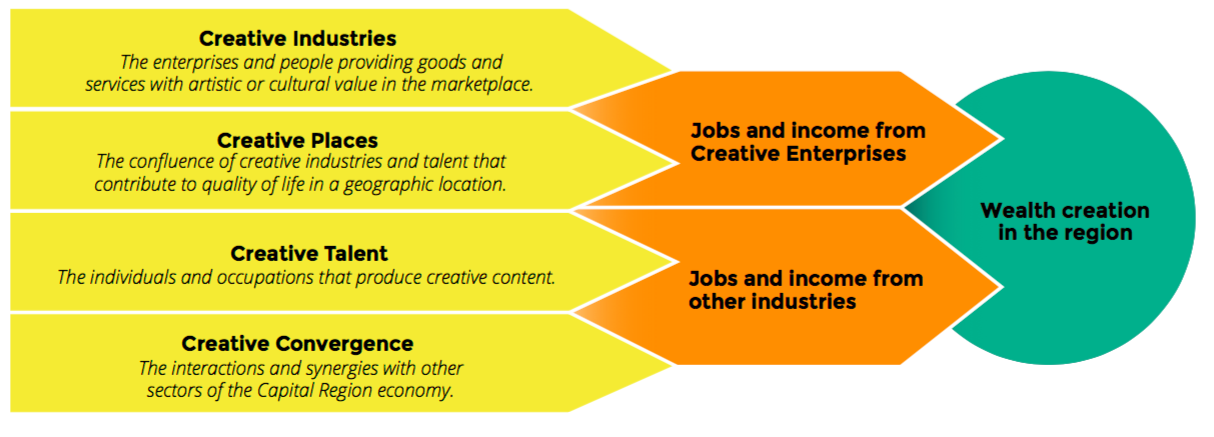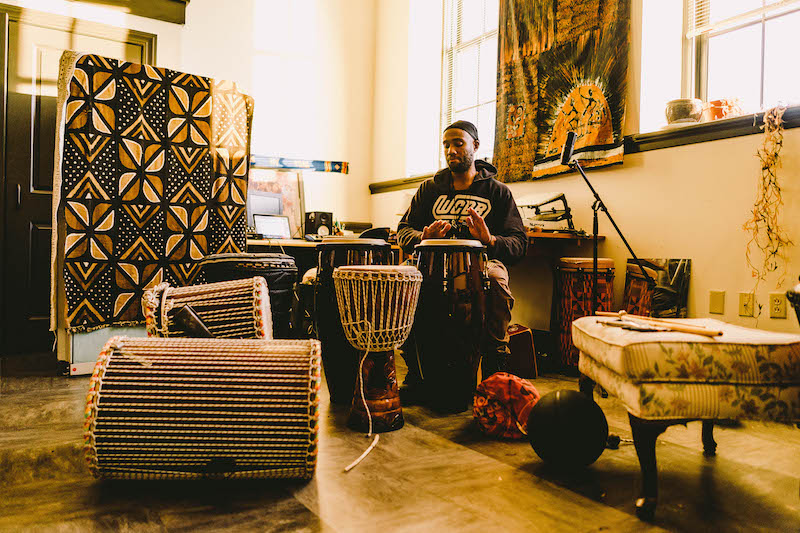In November 2014, a group of local organizations interested in the Capital Region’s creative workforce released a study examining local creative ventures and the market surrounding them while offering ideas of how to spur economic growth. Four years later things have changed. There is a general feeling that the Capital Region is on the cusp of something.
An influx of entrepreneurs and artists looking for a a place more affordable and less hectic than New York City has created an unprecedented buzz. The Alliance for the Creative Economy, an organizatiom that’s creation was spurred by the creative economy report, gathered over 3,500 creatives to their 25 regional events this year and saw a 20 percent growth in registration and attendance at their monthly mixers, according to ACE project director Maureen Sager.
Major arts institutions appear to be undergoing massive growth. The arrival of Elizabeth Sobol at Saratoga Performing Arts Center (SPAC) has seen the organization spread its influence farther afield and look to program in a more accessible and provocative manner.
Basilica Hudson’s events get bigger every year. With nonprofit status secured and state money flowing into Hudson, it is eying a move toward year-round programing by 2020. The nonprofit that owns and runs the Palace Theatre in Albany purchased the property from the city in 2018, paving the way for a proposed $65 million-dollar renovation.
Proctors has morphed into an organization called Proctors Collaborative with showplaces in Schenectady, Albany and Saratoga. The organization has plans for a new home for Capital Repertory Theatre in Albany as well as an upcoming season in Schenectady that features the Broadway smash Hamilton. (The Collaborative magazine operates under the umbrella of this organization.)
These are only a few of the major developments that will play out in 2019. They are certainly major storylines impacting the local creative economy but are they the most important ones? What should we be looking at when we try to consider the success and growth of the creative arts in the Capital Region?
We posed the question to a number of local luminaries and three topics of concern and contention became clear. The definition of the creative economy and which fields figure into it is still wildly different for many people. The possibility of an influx of creatives from NYC is something to celebrate for some and a cause for concern for others.
What is the story of the local creative economy?
For Jamel Mosely of Mel eMedia and Collectiveffort in Albany, the story is the room creative freelancers have to work with companies.
“In my experience, I see a lot of freelancers popping up, a lot of collaboration, a lot of businesses starting to realize the value in freelance work. Often with corporations, the first thing they cut are their marketing budgets. Instead of using big companies they’re reaching out to freelancers for their branding. I’ve come to that understanding through my freelance work with Mel eMedia and also our new business Collectiveffort in which we’re trying to fill in the gaps between freelancers and more expensive creative agencies.”
According to Mosely he can have up to eight freelance gigs at any time. He says he’s begun to subcontract to fulfill his obligations. “Time management has been a big thing,” he says.
For Sager, the story of the local creative economy is that its impact isn’t known as widely as it should be.
“The thing about the creative economy is that it’s made up not only of these arts and cultural organizations but also some amazing local businesses and 16,000 local freelancers who are those businesses. The creative economy has so much potential and people are only just starting to try it out.”
For Elizabeth Sobol, president and CEO of SPAC, the story of the local creative economy is that its richness and that enjoying it has become a way of life for so many of its residents.
“Since moving up here I have felt a weight lifted. While not everyone who lives in the city attends concerts as part of their job, as I did, even without that there is a still this thing where I never really went to simply enjoy a performance. I was there as part of job. In the Capital Region there are so many arts events and people attend them together as a social, communal endeavor. It’s part of the culture, it’s part of the fabric here. I’ve gone to more concerts in my time here than I think I did in years in the city and I’ve been able to actually enjoy them. Its astonishing how much the area has to offer.”
For Jean Leonard, chief of staff at Proctors Collaborative, the story is that people are finally paying attention to the story. “I think the arc is strong in our region because of our increased awareness that the arc exists! The current creative economy story is one of continuous, incremental collaborative activities that tie the region together across its city and county boundaries.”
For Elizabeth Reiss, CEO of The Arts Center of the Capital Region in Troy, the move towards creativity as entertainment has a direct correlation with the economy and political events.
“In a world that is so uncertain people have stopped spending and instead turned to what they can control and what they can make. This push toward making really started leading into 2008. I see it as a product of economic insecurity. There’s been a real trend towards one-day makers classes here. It functions as entertainment and they learn something. They aren’t’ as interested in week long, or month long classes and we’ve adapted to that. You see these ‘makers’ events at bars now and they are well attended. People want to create.”
What are these creatives looking for to gauge the success of the local creative economy?
When measuring the success of the creative economy, Sobol sees expanding opportunity for local musicians and hungry audiences.
“You can now see live jazz just about every night of the week in Saratoga. We present it at SPAC and now Caffe Lena which never presented it before. And every time I’ve gone the room has been packed. And these are local gigging musicians who are able to do what they love. There is a clear demand for their talents.”
For Sager, who says the local creative economy is very data driven, gauging its health means paying close attention to the numbers.
“In 2016, we measured $1.4 billion in creative economy earnings in the Capital Region. We try to use that data with businesses because that’s what makes creatives investable. We want to make sure there are viable jobs and that local government is providing good conditions for freelancers and small businesses to be able to attract future investment, such as the influx of private companies, and to drive growth in the area.”
For Reiss, the numbers aren’t the only important aspect to gauging a successful creative economy. Instead, the CEO is focused on what it takes to keep local artists working in preferred field.
“You can point to all these numbers and all these jobs but for me it comes down to quality of life for real artists. Yes, there are a lot of gigs out there but are these artists doing what they want to do? Are they able to make a living doing what they love? Or are they doing a million other things to put food on the table? Do they have healthcare? Can they afford rent?”
As a freelancer, Mosely measures the success of the creative economy through its creatives as well. He is especially focused on the way they can–and should–be working together in competition, recalling the term as “collaboratition.”
“I think the nature of being a freelancer is to work in this silo and that’s just not realistic. You can be competitive with someone while also being collaborative. I don’t think there are limited resources in this area. I think a knowledgeable, very educated and aware workforce of people who are willing to collaborate and help out will be the best thing.
To make it work more efficiently, he hopes the community will adopt a balanced level of peer-to-peer collaboration as well as the ability to work with those above and below one’s own skill level. I think it’s gonna take mentorship,” he says.
Leonard is focused on what she sees as the increasing awareness of the kind of impact the creative sector has on the economy. “I think the 2014 ACE report and the work done by ACE since that report was first delivered have enhanced awareness of our sector and its value in the region. That awareness, strengthened by ACE’s continuous work with freelancers and micro businesses in our region have brought the creative economy into the view of the general public. Those of us that work in the creative economy have always known we were here. Part of the job (and the value of the “arc”) is highlighting the myriad of ways the creative industries not only enhance our region but drive toward the region’s long term goals. [The report completed by ACE] found that the creative economy employs 47,282 people, continuing to drill down to define that employment and that economic impact has strengthened the creative economy’s place in the regional conversation.”
What will they be looking for in 2019 to get a sense of where it is going?
Mosely says he is watching carefully to see if there are opportunities for a more diverse group of creatives in the coming year. “I’m looking forward to a creative economy that is more inclusive, especially of people of color and people from disadvantaged and minoritized communities. I’m looking forward to trying to nurture that idea, to reach back with programs like Youth FX and Albany Barn and Tru Heart. What are the ways we can really give equity to people whose voices aren’t necessarily amplified? Sometimes we see the same people who are getting interviewed and getting awards and things like that and I can’t necessarily blame them because you oftentimes reach out to the people who are closest to you. I’m looking forward to it becoming more expansive and inclusive of all people.”
Beth Siegel, president of Mt. Auburn Associates, the firm that conducted the 2014 creative economy study, said there are a number of factors to keep an eye on, but in the end it comes down to the economic impact and the ultimate question is, “Are creative freelancers doing better than they were? What is the real life impact?”
Siegel says she believes the creation of a strong network through ACE is important to improving the life of those freelancers. Among factors she thinks are worth looking at is whether there has been an increase in performance places, makers spaces, and whether companies that use creative arts as their core—like design companies— are staying in and thriving in the region.
“There’s a focus in this country right now on ‘creative placemaking’,” says Siegel. “And while that is related to our work on the creative economy what I find much more interesting and valuable is whether people in lower income brackets are abe to benefit from a thriving creative economy.”
Since the 2014 creative economy study taken by ACE, Sager says the organization has not pursued updates concerning the past four years, but will be “discussing further” as of 2019.
“Economists and researchers have recommended updating the numbers every five years, which we are taking under advisement,” she explains.





